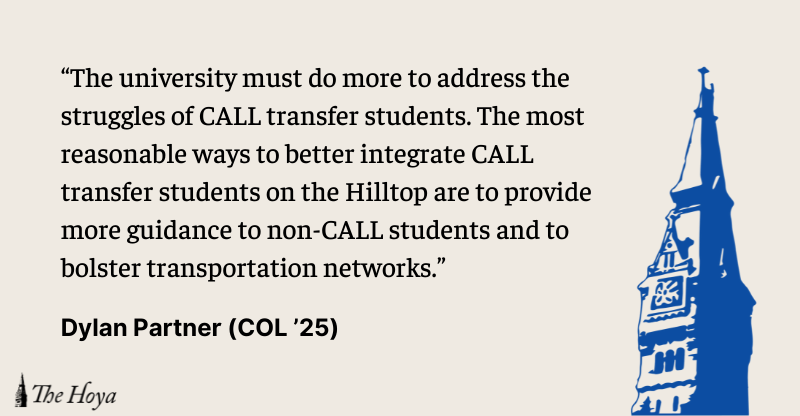The past month of my life has been a veritable whirlwind of change, but as a sophomore transfer student at Georgetown University, I expected nothing less when I submitted my application last spring.
The average new Georgetown student is thrust into an unfamiliar world with little means of navigation. But being a transfer student further complicates the scenario, as I also have to adjust to the gaping differences between my previous university and Georgetown. I transferred to the Hilltop primarily because of its stark contrast with my old college; I came from a rural campus where student organizations desperately solicited participation from a predominantly apathetic student body, and I now find myself in a bustling urban campus featuring clubs with incredibly selective admissions processes. In the space of a summer, I’ve moved from drought to glut.
However, the final and most profound variable in my experience of acclimation to Georgetown’s campus life is the fact that I’m not even on campus most of the time. I was accepted to Georgetown on the condition that I attend the Capitol Applied Learning Lab (or CALL, for short) for my first semester in Washington, D.C. I had not heard about the CALL prior to receiving the admissions email bearing its name, but I soon learned it was a program designed to immerse students in D.C. city life. With housing and classes located near Union Station, the program is designed for students in part-time internships. This means I’m within walking distance of my internship on Capitol Hill, but I’m isolated from the Georgetown Hilltop, both geographically and culturally, at a time when most transfers are expected to rapidly assimilate to its norms and customs.
On a good day, I face a 45-minute commute to the main Georgetown campus, making regular
participation in student organizations nearly impossible. That hasn’t stopped me, as well as a number of my transfer peers at the CALL, from attempting to do so. Even then, the added burden of a long commute — which can easily more than double the amount of time I devote to a particular activity — means that CALL students can easily burn out in a quicker and more spectacular fashion than a Hilltop student participating in identical activities.
The university must do more to address the struggles of CALL transfer students. The most reasonable ways to better integrate CALL transfer students on the Hilltop are to provide more guidance to non-CALL students and to bolster transportation networks.
Whenever I tell students on the Hilltop that I’m in the CALL, they typically express a vague familiarity with the program but know little about the specifics; I get a similar response from club leaders. If the university administrators who work with club leaders even suggested that leaders should consider the needs of CALL students, it would go a long way to ensuring access for students like me. Perhaps club leaders could ask on applications whether applicants reside on campus, and if so inquire whether there are any appropriate accommodations they could make for those who reside off campus.
Likewise, the Georgetown University Transportation Shuttles (GUTS) system features a new bus stop at the CALL dorm, but it is woefully inadequate. The bus comes at irregular intervals, and is not reliable, particularly on weekends. On the day of the CAB fair — when new students are exposed to hundreds of extracurricular organizations for the first time — it didn’t bother to show up at all. At a minimum, GUTS administrators should ensure that the system is reliable for both students downtown and students living on the Hilltop, with a particular focus on dependable weekend service.
There are around 30 CALL transfer students in total, comprising about half of those in the CALL program. However, we’re fewer than half a percent of the undergraduate student population, so the unique situation we’re in is perhaps reasonably not a first priority for campus administrators. If Georgetown administrators want to encourage students to join the CALL, however, they should first work to better integrate the CALL into campus life.
As my first chaotic weeks at Georgetown come to a close, I’m slowly learning how to maintain a delicate balance between the CALL and campus life. But it shouldn’t have to be this hard.
Dylan Partner is a sophomore in the College.














